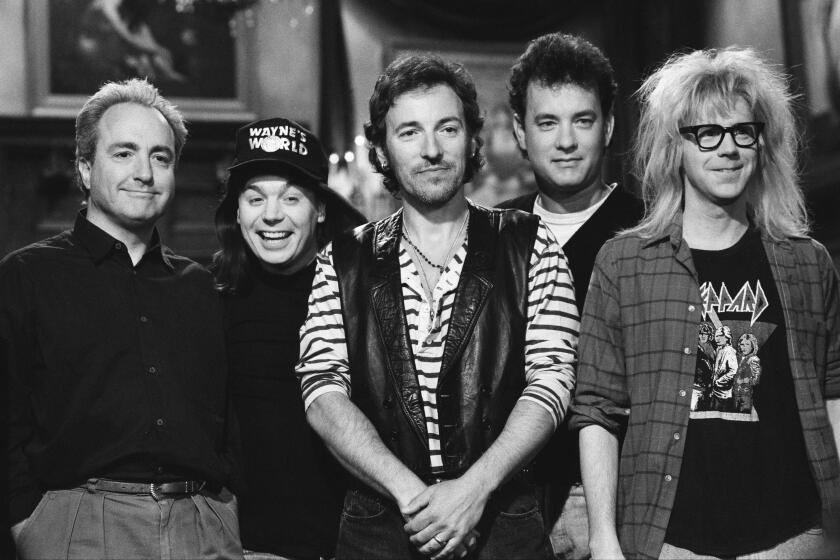DOO-DAH! Stephen Foster and the Rise of American Popular Culture.<i> By Ken Emerson</i> . <i> Simon & Schuster: 400 pp., $30</i>
- Share via
Stephen Collins Foster was the world’s first professional songwriter--first to earn his living by composing popular songs he did not perform, first to be paid in royalties rather than in flat fees. He was also the most gifted pop songwriter of the 19th century. Is there even a hymnodist who can claim a body of tunes as well-remembered as “Oh! Susanna,” “Camptown Races,” “Old Folks at Home,” “My Old Kentucky Home,” “Jeanie With the Light Brown Hair” and “Beautiful Dreamer,” to name only absolute classics? Not until George M. Cohan and Irving Berlin penned their songs in the 20th century did such durability begin to seem a realistic possibility. Such successors to Foster as Henry Clay Work, who wrote “Marching Through Georgia” and “My Grandfather’s Clock,” and Charles Harris, who self-published “After the Ball,” fell well short.
The story of Foster’s brief life remains obscure primarily because his survivors wanted it that way. As Ken Emerson notes in “Doo-Dah!” the first true biography of Foster in more than 60 years and the only good one (although William Austin’s 1975 “ ‘Susanna,’ ‘Jeanie,’ and ‘Old Folks at Home’ ” is superb musicology), a mere 30 of Foster’s letters have come down to us. Most of the others were destroyed by Morrison Foster, the only one of four brothers to live to old age and the author in 1896 of a memoir. But as Emerson suggests, Foster’s story also remains obscure because the culture he represents isn’t considered worthy of the scholarly digging that can cast light into the corners of history. Emerson, a journalist working with a commercial publishing house, deserves thanks for meticulously researching a project unlikely to garner him many professional perks.
In a way, the paucity of materials was a blessing. Additional facts about this shy young man’s struggles with composition and his contact with African Americans and their music would be immensely valuable, and it would be nice to know more about the inner life and external transgressions of his intermittently estranged wife, Jane (with the light brown hair).
But at least Emerson wasn’t tempted to write one of those month-by-month play-by-plays that turn biography into brick-laying. Instead, he breaches scholarly decorum by finding similarities between Foster’s life and the lives of his contemporaries: pioneering Afrocentrist Martin Delany, who came to Pittsburgh as a teenager in 1827, a year after the composer was born; the slightly later Pittsburgh success story of Andrew Carnegie; Harriet Beecher Stowe, who wrote the novel that would ensure Foster’s fame in the most important of his homes away from home, Cincinnati; Edgar Allan Poe, caught in a comparable cycle of success and failure; and Louis Moreau Gottschalk, the New Orleans-born classical composer-pianist whose celebrity outstripped Foster’s, although he was such a troublemaker he didn’t outlive him by much. As a result, Emerson’s biography doubles as a cultural history--for its first hundred pages, as balanced and authoritative a summary of early American popular music as anyone has devised.
In the definitive tension of Foster’s art, the parlor ballad fended off blackface minstrelsy. The parlor embodied middle-class comfort with the express purpose of putting a polite face on domestic life; blackface minstrelsy embodied a “freedom from bourgeois conventions and expectations” for the predominantly male audience that felt the call of its rough humor and jumpy music. But both were recent developments that fed off innovations in piano manufacturing and transport, printing, communications and travel. And though minstrelsy came later and proved to be the wave of the future, its victory was hardly unequivocal. Emerson lays out this complex story with grace, originality, dispatch and a level of insight that owes much to his experience as a rock critic.
Because writers gravitate toward verbal texts, and because the rhythms and timbres of minstrelsy’s performance-defined style are difficult to reconstruct even when sheet music survives, most accounts of blackface concentrate on its scripts. And judged by its scripts, minstrelsy’s racism is so blatant that commentators are hard-put to notice much else. Emerson emphasizes that racism also infected the music. But his critical orientation helps him understand that the stolen, emulated, aped, fabricated and faked “blackness” of minstrel songs announced a change in the way Americans would make music far more fundamental than anything portended by the class animosities of minstrel theater. Moreover, he knows his pop music well enough to find relevant recent comparisons--between 19th century English singer and songwriter Henry Russell and Elton John, and Foster’s confusion over the Civil War and the Beach Boys’ Brian Wilson’s over Vietnam.
Although Foster’s family is often described as educated and well-to-do, Emerson establishes that it was only genteel and prominent; renowned relatives, including James Buchanan, couldn’t save Foster’s father from bankruptcy while he was mayor of the Pittsburgh suburb of Allegheny City.
His family’s many moves and ingrained sense of dashed opportunity lent extra savor to the longing for home that Foster shared with a century whose signature song was “Home Sweet Home”--a nostalgia that obviously infused “Old Folks at Home” and “My Old Kentucky Home,” if not “Oh! Susanna” or “Camptown Races.” And although the latter two songs--bright, energetic, apparently meaningless divertissements with no parlor in them, both containing convincing lyrical themes of the sort resented by Philistines who believe a ditty is a ditty is a ditty--represent a peak for Foster, there’s no denying that the composer was informed and animated by the ideal of an all-nurturing home even when he was escaping it. Hence, both the great “Home” songs were also “Ethiopian songs” (as opposed to elevated fare like “Jeanie” and “Beautiful Dreamer”), although the title phrase in the one about the Swanee River was changed from “Old Blacks at Home” and “My Old Kentucky Home” rejected the gratuitous dentals and other demeaning cliches of blackface dialect convention.
Like his father, Foster had big ideas and no head for business. The decent money he made in the early and mid-1850s was never on a par with his fame, which was spread not just by minstrel troupes but by countless musical productions of “Uncle Tom’s Cabin.” Emerson believes Foster was drinking heavily as early as 1852 and, by the time he settled in New York in 1860, he was a half-forgotten alcoholic who wrote for cash on the barrelhead. This was his most prolific period and his worst; great pop songs aren’t cranked out by formula any more than any other kind of art.
Although Foster’s racial attitudes were suffused with a sympathy that touched millions--not all of them white--his family ties to the anti-abolitionist Democratic Party ill-prepared him for the Emancipation Proclamation. Emerson doubts that Foster could have adjusted to post-Civil War America. But we’ll never know if he had any “Beautiful Dreamers” left. He died in 1864 in a shabby Manhattan hotel at 37.
More to Read
Sign up for our Book Club newsletter
Get the latest news, events and more from the Los Angeles Times Book Club, and help us get L.A. reading and talking.
You may occasionally receive promotional content from the Los Angeles Times.









